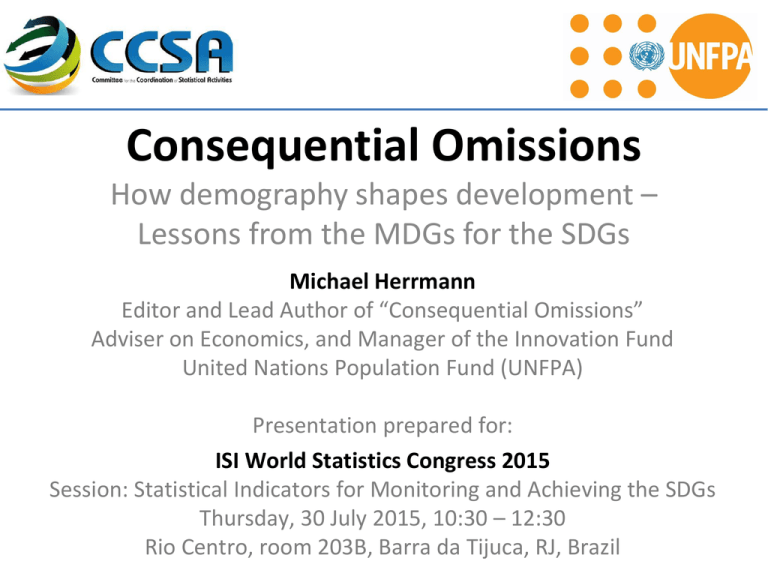Consequential Omissions How demography shapes development –
advertisement

Consequential Omissions How demography shapes development – Lessons from the MDGs for the SDGs Michael Herrmann Editor and Lead Author of “Consequential Omissions” Adviser on Economics, and Manager of the Innovation Fund United Nations Population Fund (UNFPA) Presentation prepared for: ISI World Statistics Congress 2015 Session: Statistical Indicators for Monitoring and Achieving the SDGs Thursday, 30 July 2015, 10:30 – 12:30 Rio Centro, room 203B, Barra da Tijuca, RJ, Brazil This Presentation • Looking back How demographic change influenced progress to MDGs • Looking forward How projected demographic changes are likely to affect progress to SDGs • Implications How to shape and plan for demographic change and priorities for the SDGs Looking back • Relative targets 1.A: Halve, between 1990 and 2015, the proportion of people whose income is less than one dollar a day. • Relative targets 1.A: Halve, between 1990 and 2015, the proportion of people whose income is less than one dollar a day. • Absolute target 7.D: By 2020, to have achieved a significant improvement in the lives of at least 100 million slum dwellers. • Universal targets 2.A: Ensure that, by 2015, children everywhere, boys and girls alike, will be able to complete a full course of primary schooling. Looking forward Implications Three priorities for sustainable nexus • Inclusive economy: Necessity - Full, productive and remunerative employment - Social transfers/ protection/ distribution - Economic resources/ social consensus • Green economy: Not a luxury - Increase in resource efficiency - Reduction in waste and emissions - Reliance on renewable, clean, safe energy - Structural change • Demography: Not destiny - Universal access to sexual and reproductive health - Investment in education beyond primary level - Empowerment of girls and women - Systematic use of population data and projections Priorities in the Post-2015 Development Agenda • Promote more inclusive economies End poverty (goal 1) – End hunger (goal 2) – promote inclusive growth (goal 8) – promote inclusive industrialization (goal 9) – reduce inequality within and among countries (goal 10) – make cities and human settlements inclusive (goal 11)… • Promote greener economies Ensure availability of water (goal 6) – ensure access to modern energy (goal 7) – Ensure sustainable consumption and production (goal 12) – Combat climate change and its impacts (goal 13) – Conserve oceans, seas and marine resources (goal 14) – Sustainable use of terrestrial ecosystems (goal 15)… • Address and harness population dynamics Ensure healthy lives (goal 3) – Ensure education (goal 4) – Achieve gender equality and empower all women and girls (goal 5)… Priorities for Implementation and Achievement • Shape demographic change - Reduction in child mortality - Access to sexual and reproductive health - Access to voluntary family planning - Education beyond the secondary level - Achievement of gender parity in education - Abandoning of child marriage - Empowerment of women - Plan for demographic change - Collect population data: vital registration, censuses, etc. - Produce population projections: national and sub-national - Use population projections for planning: National development strategies, etc. To request a copy of “Consequential Omissions”, please send an email to Michael Herrmann at herrmann@unfpa.org




